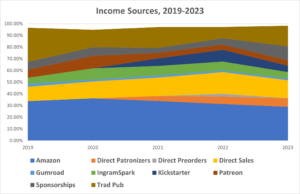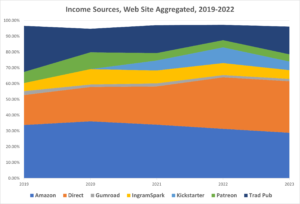Here’s where my income came from in 2023. (For newcomers, I’ve done these posts for the last few years.)
I’m a writer. My income comes from writing books and making them available. I publish both independently and through publishers. I don’t consult. I don’t seek out speaking fees. I desire to make my living as an author, creating and licensing intellectual property. I make my books available in every channel that offers reasonable terms.
Whenever I share actual dollar figures, people inform me that I can’t possibly be making that much, or that I don’t deserve to make that much, or demand I share “the secret.” The first two are not worth my time, and I’ve been trying to tell everyone the dang secret for years: keep writing, with an attitude of deliberate practice. Nothing productive can come from such discussions, so I don’t say.
How did 2023 look?
My income was flat with 2022 and 2019. While the Great Locked Inside Reading Surge of 2020-2021 supplemented my emergency fund, my income is back at its baseline. I’d like more, sure, but I have achieved Enough. Not bad for a year without many books.
Here’s the detail.
Amazon – 28.87%
Trad Pub – 17.55%
TWP direct sales – 15.29%
TWP sponsorship – 12.00%
TWP patronizer – 7.42%
IngramSpark – 5.54%
Kickstarter – 5.46%
Patreon – 4.56%
Gumroad – 1.53%
Apple – 0.70%
Kobo – 0.50%
Google – 0.37%
Draft2Digital – 0.17%
Aerio – 0.03%
Barnes & Noble – 0.01%
Can I draw any conclusions from this?
My web site (TWP, or Tilted Windmill Press) is again this year’s star. The combination of direct sales, sponsors, and my homebrew Patreon is 34.71% of my income, a couple points over last year. It’s built on Woocommerce with a handful of commercial plugins that total about $600 a year. My business goal is to get folks to buy directly from me rather than retailers, so I’m content but not satisfied.
Amazon is at 28.87%, down a couple points from last year. There’s reasons for that. They don’t have rights to distribute my newest tech book on Kindle. They’ve retaliated by deprioritizing the title in their listings. I’m not crying; I consider Amazon a discovery platform, an entry point to the Reader Acquisition Funnel. I neither love nor hate Amazon. They’re merely a retailer who offers a nonnegotiable take-it-or-leave-it deal. I accept or reject that deal on a case-by-case basis. Losing them as a channel would send me back to the “yellow zone” emergency budget, but we’d survive just fine.
Kickstarter is down, but I only ran campaigns for short story collections. My private Patronizer program grew a point, but that’s a wobble not a trend. Traditional publishing income is up, thanks to a Humble Bundle.
Then there’s the “below two percent” retailers. Gumroad, because they handle VAT for European readers. I want all the readers and Apple, Kobo, and Google serve readers other retailers don’t reach. They’re small, but those nickels spend. Unless things change, this will be the last year I report Barnes & Noble. I spent many happy hours in the 90s and the 00s wandering their aisles and I would like them to be successful for old times’ sake, but they’re just not managing it and their numbers depress me.
Here’s what the last five years have looked like. I have excluded the tiny channels.
It’s hard to call most of these lines “trends.” If you aggregate the various options from my web site, though, you can see a couple things.
Having fewer entities on this graph makes a couple things clear. I dislike that IngramSpark is shrinking year over year. I use IS to fulfill non-Amazon paperback orders and all hardcovers, so this is either an indication that either brick-and-mortar bookstores are struggling, or that I haven’t released a “hit” in a couple years. Which is it?

It also shows that my direct-to-reader business efforts are working. Readers are willing to do business directly with writers. They like supporting individual authors.
What does the swell in trad pub mean? It means that I need multiple sources of income. I have no way to control which business partner will prosper and which will pull a Wile E Coyote. No matter what, I must be able to pay the mortgage.
How much do I make off of sponsorships and Patronizers, as opposed to retailers? Fair question. Let’s see.
After a few years of growth, the non-retail income is down. Sponsorships and Patronizers were up, but Kickstarter was down (again, because I didn’t run a big one). The vital lesson here is:
if I don’t put broadly interesting product in front of people, I don’t get paid.
Now that I’ve shared the secret, it’s time to double-check last year’s expenses. Income is great, but it’s expenses that destroy you.














